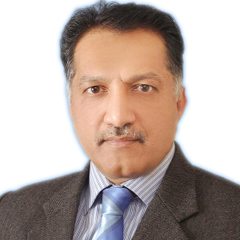
A commonly observed phenomenon is that Germans have two faces. One is apparent outside Germany and the other is visible inside Germany. In Islamabad, Germans are found advocating pluralism and open-mindedness but, in Berlin, the opposite of these virtues rules. Meet a German in London or Chicago and find a liberal, egalitarian person in him. Meet the same German in Frankfurt or Bonn and find a conservative, narrow-minded person in him. The paradox is shocking. Nevertheless, conservatism and narrow-mindedness are still mild words; racism is a proper word.
Since mid-October this year, every Monday evening, a demonstration is held in Dresden, East Germany, against foreigners, especially Muslim asylum seekers who have fled from war-zones such as Iraq and Syria. In these ‘Monday demonstrations’, the demonstrators wave flags, fliers and placards painted with Nazi emblems — swastikas (i.e. the gammadion cross) — and call themselves neo-Nazis. They also chant slogans that, after the fall of the Berlin Wall in 1989, there is no place for any foreigner in Germany. Apparently, they are inspired by Thilo Sarrazin (a senator in Berlin) who, in 2010, expressed his anger at the presence of Muslims in Germany. To meet the objective, an organisation has been formed called PEGIDA, an acronym that stands for Patriotic Europeans Against the Islamisation of the West. Reportedly, the workers of far right political parties such as the National Democratic Party (NPD) and Alternative for Germany (AfD) are behind these demos that are gradually growing in number despite the immense cold and are branching out to other cities in Germany. The AfD, which is anti-Euro in its stance, is part of the parliament from Saxony (where the Dresden is located), besides two other states, and its head Bernd Lucke has publicly supported PEGIDA. The recent reported figure of participants in the protest demonstration in Dresden only (risen from 5,000 in October) exceeded 15,000 on December 15.
German Chancellor Angela Merkel has condemned PEGIDA but PEGIDA’s supporters are growing with each passing week as certain right-wing parliamentarians are supporting it. Secondly, no doubt, there are counter-demonstrations taking place (in favour of foreigners); one took place on December 8 in Dresden (e.g. Dresden Alliance without Nazis) but these are attracting comparatively fewer participants. These counter-demonstrations, which raise their slogans mostly in English, are more focused on the face saving of Germany than addressing xenophobic trends in society. PEGIDA has hired the services of soccer hooligans to shout racist slogans, intimidate foreigners and ward off the police. In any protest turned violent, PEGIDA or its offshoots have taken over the police; in Hanover, West Germany, 50 police officers were injured in October.
PEGIDA has also launched a hate campaign against Muslim asylum seekers who are living in slums by calling them thieves and criminals. Some time ago, the swastika brandishing protestors attacked and set ablaze residences constructed in Dresden and in Vorra near Nuremberg for asylum seekers. Considering foreigners criminals is based on the assumption that Germans are not criminals. Interestingly, the past history of the head of PEGIDA, Lutz Bachmann, is itself full of crimes such as burglaries, drunk driving and drug addiction. This point gives birth to the second interesting aspect: in the Saxony state, only two percept of the population is foreigners and of them just a fraction are Muslims.
Some people view the rise of PEGIDA as an East Germany phenomenon (viewing that East Germany was socio-economically and politically backward) but they are unable to answer the reason behind the spread of PEGIDA’s ideology to the cities of West Germany. There, PEGIDA is rearing its head under synonymous names such as Bonn has a Bogida march and Wurzburg has a Wugida march. This point engenders the third interesting aspect: PEGIDA has launched its anti-Muslim campaign from Dresden to protect Europe from the Muslims.
It seems that submerged ideas of hatred against foreigners are resurfacing after the fall of the Berlin Wall in 1989. The PEGIDA phenomenon brings along certain perturbing aspects. First, in the early 1990s, foreigners were physically attacked and killed in the towns of Hoyerswerda, Hunxe, Molln, Solingen and Rostock. For instance, on May 29, 1993, the home of a Turkish family was set on fire killing five Turks, including three children in the city of Solingen (in the state of North Rhine-Westphalia). This is the same state that doomed the political future of former German Chancellor Gerhard Schroder (because of his liberal and progressive policies) and made Merkel, with her right-wing populism and conservatism, win the 2005 elections. The worrying sign is that, at that time, young skinheads were the proponents of xenophobia but this time they are not the main part of protestors.
Secondly, publicly raising slogans and the participation of workers from right-wing political parties running the government is quite a new occurrence that has smashed the societal taboo against the expression of xenophobic or racist sentiments on the streets. Pakistani communities, especially inhabiting Frankfurt and Berlin, are concerned about the rise of PEGIDA in all its forms; they even tell their children not go out of the house alone and unnecessarily. In Hanover, the police union chairman, Rainer Wendt, has shown the inability of the riot police to bring those motivated by PEGIDA’s anti-multiculturalism ideology under control.
Thirdly, PEGIDA demonstrations serve the purpose of making resentment viral and the expression of racism in the name of anti-Muslim sentiments possible. This hatred is being rationalised and the risk is that, under the spell of mob instinct and given the past history of fatal attacks against foreigners, any group of hooligans can commit any kind of atrocities against foreigners, especially Muslims of Pakistani origin in Germany. It is not known what diplomatic measures the Pakistani government has undertaken to condemn the PEGIDA phenomenon and ensure the safety of Pakistani students residing in Germany.
The writer is a freelance columnist and can be reached at qaisarrashid@yahoo.com
